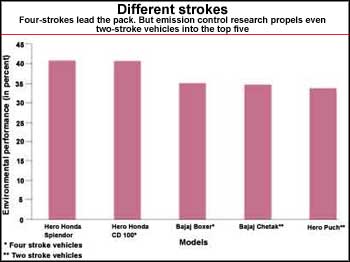Changing gears
 when Brij Lal Munjal of Hero Honda Motors decided to invest in four-stroke engines in 1984, industry circles thought it was quixotic. This was the time when two-strokes were ruling the roost. But the gamble paid off. Today, he is laughing all the way to the bank. Four-stroke engines have proved to be superior to two-stroke in more ways than one.
when Brij Lal Munjal of Hero Honda Motors decided to invest in four-stroke engines in 1984, industry circles thought it was quixotic. This was the time when two-strokes were ruling the roost. But the gamble paid off. Today, he is laughing all the way to the bank. Four-stroke engines have proved to be superior to two-stroke in more ways than one.
grp has found that emissions from two-stroke engines are much higher than four-stroke engines. For two-stroke two-wheelers without the catalytic converter, the difference in emissions is staggering. On an average, the total regulated tailpipe emissions from a two-stroke two-wheeler without catalytic converter is 2.5 times more than that of the four-stroke two-wheelers. Despite having a small engine size (less than half that of the four-stroke two-wheelers), the average fuel efficiency of two-stroke two-wheelers is 15 per cent lower than that of the four-stroke two-wheelers.
The analysis clearly shows the overwhelming superiority of four-stroke two-wheelers over two-stroke two-wheelers with respect to emissions and fuel efficiency. Still, 60 per cent of the two and three-wheeler segment is two-stroke. Despite the benefits, half of the two-wheeler companies have not taken any initiative to move to lesser polluting options. But some companies like Bajaj have invested in research to control emissions from two-stroke engines. This explains their standing in the top five product ratings. Similar research for four-stroke engines would have revved up their environmental performance.
However, there are better options that haven't made inroads in the auto sector. One of them is the hybrid engine. These use both gasoline as well as fuel cells and emit just half of that of four-stroke engines. Electric vehicles, of course, are the best because they have zero tailpipe emissions. However, none of the companies are moving towards these options.
Electric three-wheelers produced by Scooters India Ltd are one of a kind in India. The proportion of total products produced by a company on various engines (corporate engine performance) is a good indicator to reflect the overall environment performance of the entire product-range of a company. Going by this parameter, grp found that almost all companies had a poor corporate engine performance record. This is because of their reluctance to invest in cleaner technologies like fuel cells.
Related Content
- COVID-19 and food (in)security in Africa
- Switching gears: achieving climate smart fisheries
- Climate action to unlock the inclusive growth story of the 21st Century
- Accelerating climate and disaster resilience and low-carbon development through the COVID-19 recovery
- Transforming the world through food and agriculture: FAO and the 2030 Agenda for Sustainable Development
- The Paris Targets
